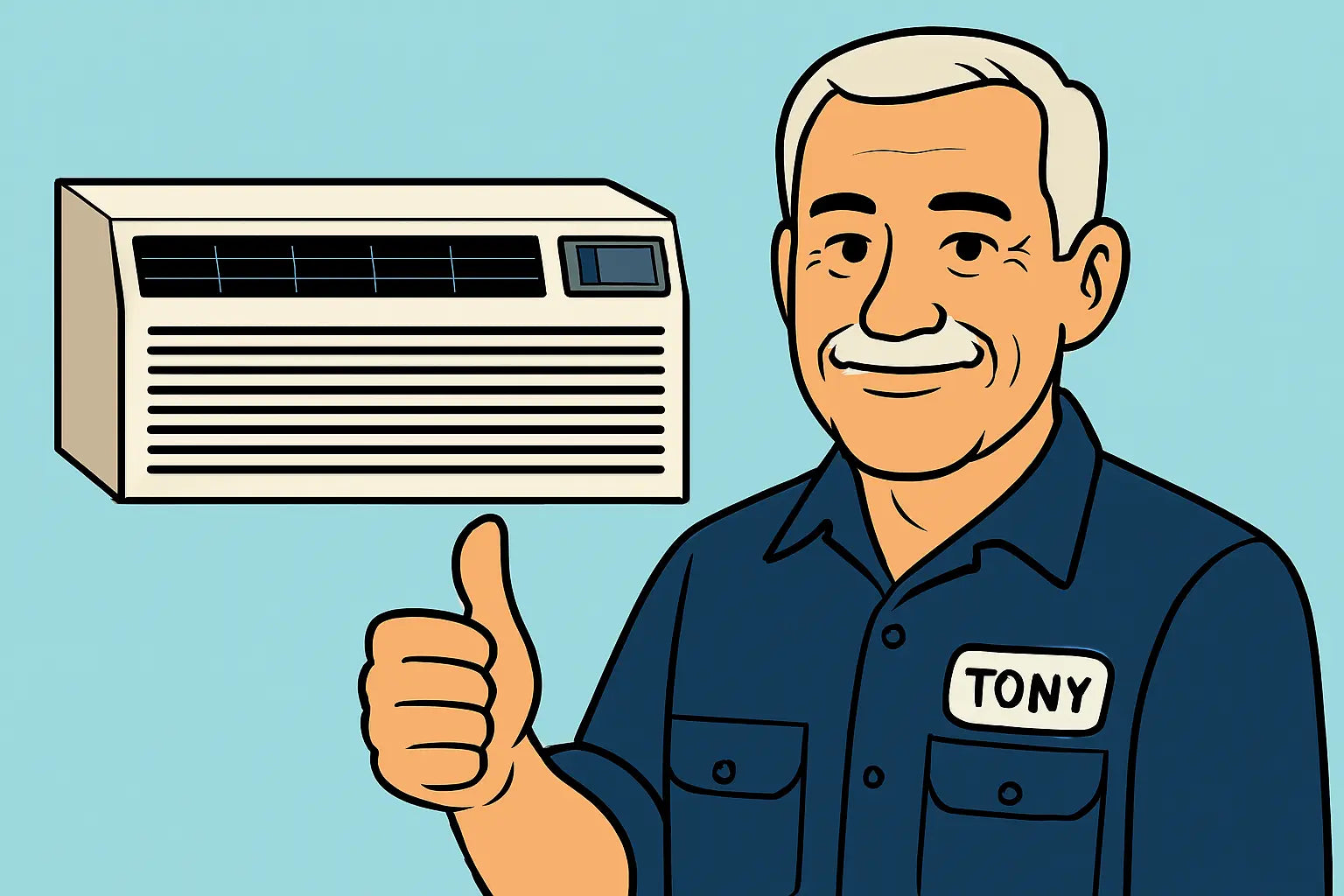Intro from Tony
Hey friends, Tony checking in. We’ve installed our Amana Distinctions 12,000 BTU PTAC with 3.5 kW electric heat, maintained it, and even optimized sleeve tilt and drainage. But sometimes, despite your best efforts, things go sideways. Maybe the unit won’t start, the electric heat isn’t kicking in, or water’s pooling indoors.
Now comes the big question: do you tackle it yourself or call a professional? Today, I’m walking you through the costs, risks, and practical tips for DIY vs professional repair. By the end, you’ll know exactly when it’s worth rolling up your sleeves—and when it’s time to pick up the phone. 😎🛠️
1. Common PTAC Problems Homeowners Face
Here are the most frequent headaches with the Amana Distinctions 12,000 BTU PTAC:
-
No power or intermittent operation
-
Weak cooling or heating
-
Water leaks from condensate or sleeve issues
-
Noise or rattling
-
Error codes indicating electrical or component faults
Understanding the problem is step one before deciding if you can DIY or need a pro. For a deep dive into PTAC troubleshooting, see HVAC Senior PTAC guide.
2. DIY Repairs: When You Can Safely Fix It Yourself
2.1 Ideal DIY Scenarios
-
Replacing or cleaning filters
-
Clearing minor coil dust or debris
-
Tightening loose panels or screws
-
Checking and clearing minor drain blockages
-
Resetting breakers or LCDI cords
2.2 Tools You’ll Need
-
Screwdrivers and drill
-
Level and shims
-
Soft brush or vacuum for coils
-
Multimeter for basic voltage checks
-
Gloves and safety goggles
2.3 Cost and Time
-
Typically under $50 for replacement filters, cleaning solutions, and minor hardware
-
Time: 30 minutes to 2 hours depending on the task
For a step-by-step DIY guide on filter and coil maintenance, check Bob Vila’s AC maintenance guide.
3. Professional Repairs: When to Call a Licensed Technician
3.1 Scenarios Requiring a Pro
-
Electrical issues beyond breaker or cord reset
-
Refrigerant concerns or heat pump failure
-
Persistent water leaks despite cleaning and tilt adjustment
-
Compressor or motor replacement
-
Unreadable or persistent error codes
3.2 Costs to Expect
-
Service call: $100–$150
-
Labor for repairs: $75–$120 per hour
-
Parts: $50–$300 depending on component
A licensed technician ensures safety, warranty compliance, and proper repair, especially for electrical or refrigerant-related issues.
For guidance on hiring a professional, see Energy Star's HVAC tips.
4. Risks of DIY Repairs
-
Electrical shock or short-circuiting
-
Refrigerant exposure (illegal and dangerous without certification)
-
Improper reassembly causing leaks or noise
-
Voiding manufacturer warranty
Even a small misstep with wiring or the 3.5 kW electric heat can lead to costly damages—or worse, safety hazards.
For general PTAC electrical safety, check PTAC inc's PTAC tips.
5. Risk vs Reward Analysis
| Task | DIY Feasible? | Risk Level | Notes |
|---|---|---|---|
| Filter replacement | ✅ | Low | Easy, saves money |
| Coil cleaning | ✅ | Low–medium | Avoid bent fins |
| Tighten panels | ✅ | Low | Minor savings |
| Electrical issues | ❌ | High | Safety hazard |
| Refrigerant or compressor | ❌ | High | Call licensed tech |
| Persistent leaks | ❌ | Medium–High | Could damage walls/floor |
6. Safety Tips for DIY Repairs
-
Always turn off breaker and unplug the PTAC before touching wires.
-
Wear gloves and safety goggles.
-
Keep a bucket or towel handy for minor water leaks.
-
Document steps before disassembly to avoid reassembly mistakes.
For comprehensive DIY safety, check Genuine Comfort PTAC safety guidelines.
7. Making the Decision: DIY vs Professional
Ask yourself:
-
Do I have the tools and skills to safely complete this repair?
-
Does the repair involve electricity, refrigerant, or internal components?
-
Could I void warranty or cause bigger damage if I try DIY?
If you answered “no” to any of these, it’s time to call a licensed technician. Otherwise, minor fixes like filter cleaning, panel tightening, or basic coil cleaning are totally feasible DIY tasks.
8. Tony’s Pro Tips
-
Keep a maintenance log for filters, coils, and electrical checks.
-
Schedule annual professional inspection even if DIY maintenance is done regularly.
-
Don’t ignore small issues; early action often avoids costly repairs.
-
Always reference the Amana Distinctions installation and service manual for model-specific guidance.
Final Thoughts from Tony
And that’s your Tony-approved guide for DIY vs professional repair for the Amana Distinctions 12,000 BTU PTAC with 3.5 kW electric heat. Know your limits, weigh the costs, and protect your safety. Do the small stuff yourself, call a pro for the tricky parts, and your PTAC will stay humming efficiently for years.
If you haven’t grabbed this model yet, or want a refresher on specs, check out The Furnace Outlet’s Amana Distinctions PTAC. Install it, maintain it, and repair it wisely—and you’ll enjoy comfort without drama. 🍻
Need more installation and troubleshooting tips for your Amana PTAC unit? Visit my guide right here!
Until next time,
- Tony the Trusted Tech







